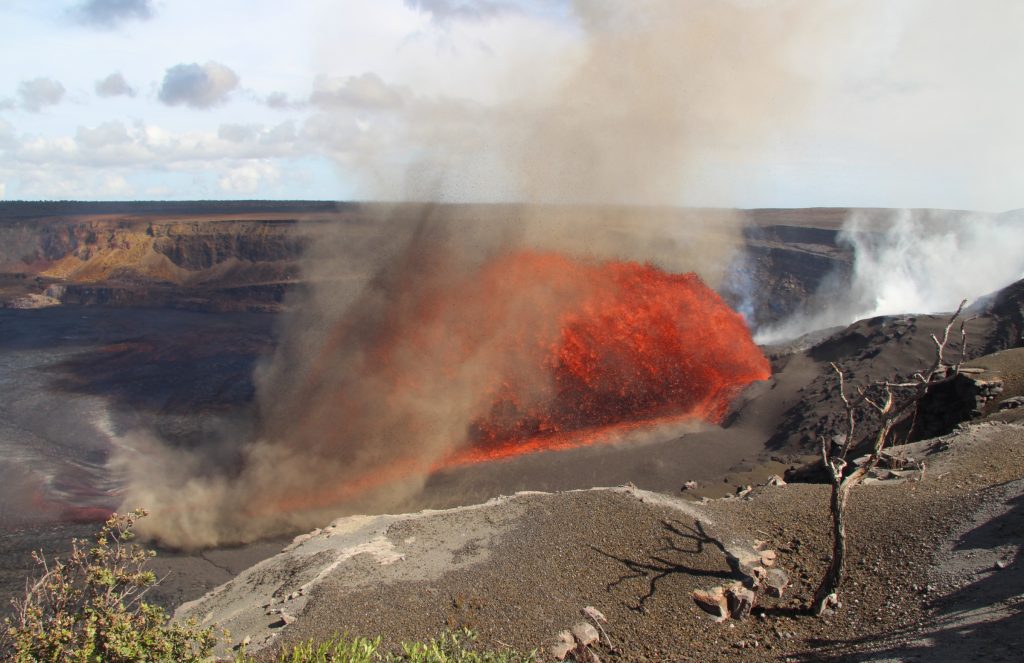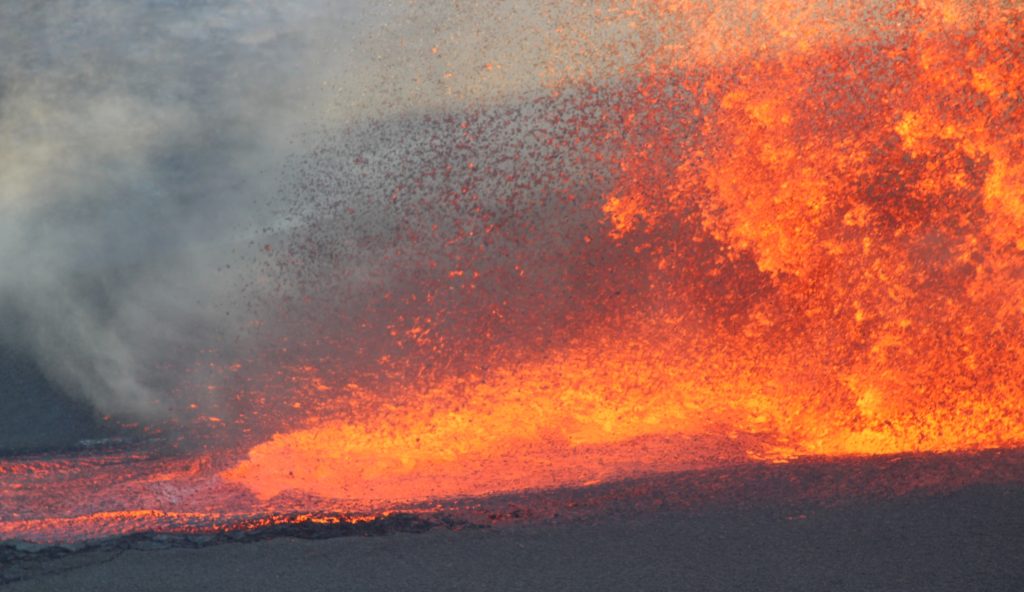Episode 31 of ongoing Kīlauea summit eruption ejects 10.9M cubic yards of lava
You grow up in your teens, mature throughout your 20s and when you reach your 30s, sometimes you make a change. The ongoing episodic summit eruption at Kīlauea volcano on the Big Island is taking a similar path.
Episode 31 of continuous lava fountaining within Halemaʻumaʻu Crater inside Kaluapele, the volcano’s summit caldera — which lasted 12.6 hours from just after 2 p.m. Aug. 22 to shortly before 3 a.m. Aug. 23 — was a prime example.

Geysers erupted one of the highest volumes of molten rock recorded yet since the eruption began Dec. 23, 2024.
Hawaiian Volcano Observatory reported lava fountains pumped out an impressive about 10.9 million cubic yards of lava at an average of 240 cubic yards per second, eventually covering 75% of the Halemaʻumaʻu Crater floor in the southern part of the caldera.
Fountains from the north vent reached heights of up to 325 feet, sustaining that height during most of Episode 31. At first glance, that doesn’t seem too impressive compared to geysers during some past episodes that reached to more than 1,000 feet — shooting high above the crater’s rim.
Until you turn those fountains sideways.
Inclined lava geysers — that began to arc like a bow at about 2:18 p.m. Aug. 22 — instead extended 1,000 feet laterally from the north vent, sending molten rock eastward toward the center of Halemaʻumaʻu Crater.
Eruptions at Kīlauea Iki in 1959 and Maunaulu in 1969 featured similar episodes of lava fountaining. In both of those cases, inclined fountains were caused by temporary obstructions inside the eruptive vents — usually a collapse of part of the vent or surrounding cone.
“It’s similar to if you’ve ever put your thumb over a garden hose, causing the water to spray out of the hose at an angle,” explained Hawaiian Volcano Observatory.
The voluminous fountaining was preceded by continuous spattering in the north vent that began at about 8:30 a.m. Aug. 22. Spattering continued to increase in intensity until sustained lava overflows began at 11:45 a.m.
A cone was built inside the vent during the little more than 3 hours spattering intensified, sealing off part of the old vent. Observatory scientists said that inner cone is a likely suspect for why lava fountains eventually went sideways instead of up.
Fountaining in the north vent increased significantly at 2:04 p.m., accompanied by deflationary tilt and increasing tremor, marking the beginning of Episode 31. Geysers settled into their incline and began arcing less than 15 minutes later at a height of about 100 feet.
They also fed multiple lava streams onto the crater floor.

Unlike many of the eruptive episodes during this ongoing Kīlauea summit eruption, No. 31 had a primary lava channel exclusively fed by molten spatter rather than lava upwelling from the north vent.
Low spatter fountains then began feeding a small flow from the south vent sometime between 4 and 5 p.m., and a new intermediate vent opened up at 7:23 p.m. in the area of glowing cracks between the north and south vents.
Lava geysers from the south and intermediate vents remained small throughout Episode 31, less than 33 feet for most of the time. Fountains from the intermediate vent increased, however, to between 60 and 100 feet by the evening of Aug. 22.
The south and intermediate vents stopped erupting at about 12:40 a.m. and 2:46 a.m. Aug. 23, respectively, with activity from the north vent stopping abruptly at about 2:52 a.m., bringing an end to Episode 31.
Hawaiian Volcano Observatory said lava flows from this episode could continue to exhibit slow movement or incandescence as they cool and solidify throughout the coming days.
About 22 microradians of deflation were recorded at the Kīlauea summit during this episode.
The end of eruptive activity — as has been typical throughout this episodic summit eruption after each fountaining event — coincided with a rapid change from deflation to inflation at the summit and decrease in seismic tremor intensity.
The Uēkahuna tiltmeter had recorded just more than 1 microradian of inflationary tilt as of 8:48 a.m. Aug. 23, about 6 hours after Episode 31 ended.
Most episodes of Halemaʻumaʻu lava fountaining since the eruption started continued for about a day or less and were separated by pauses in eruptive activity of generally at least several days.
No changes have been detected in the East Rift Zone or Southwest Rift Zone of the volcano.
Kīlauea’s Volcano Alert Level remains at Watch and its Aviation Color Code continues at Orange.
All current and recent activity is within Hawaiʻi Volcanoes National Park.
Windblown volcanic material such as Pele’s hair and tephra could affect areas downwind of the eruptive vents even now after lava fountaining has stopped.

Elevated degassing also continues despite volcanic gas emissions greatly decreasing since the end of Episode 31.
Average sulfur dioxide emission rates — a main ingredient in volcanic smog, or vog — are usually between 1,200 and 1,500 tonnes per day between eruptive episodes, though can vary on short time scales in association with gas-pistoning.
Other significant hazards also remain around Kīlauea caldera — an area closed to the public since late 2007 — including Halemaʻumaʻu Crater wall instability, ground cracking and rockfalls that can be enhanced by earthquakes within the area closed to the public.
Hawaiian Volcano Observatory continues to closely monitor Kīlauea and will issue a Volcanic Activity Notice at the start of the next eruptive episode. If possible, a status report will also be released beforehand upon the onset of low-level precursory activity.
Regular Kīlauea updates are posted daily at the Hawaiian Volcano Observatory website.
Keep an eye on Kīlauea yourself by checking out the three available U.S. Geological Survey summit livestream cameras.



